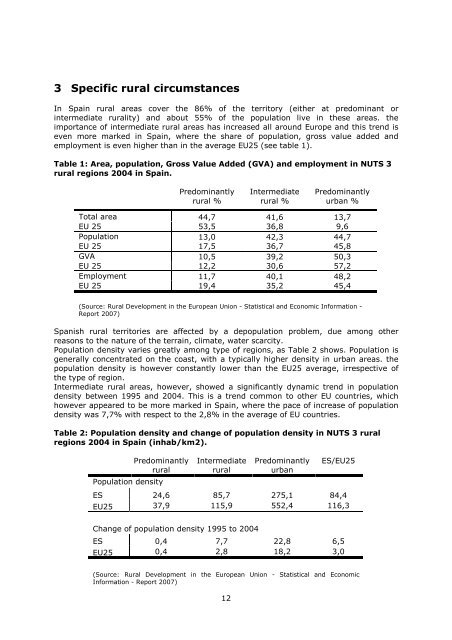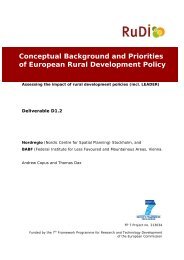Country profile on rural characteristics Spain - RuDI
Country profile on rural characteristics Spain - RuDI
Country profile on rural characteristics Spain - RuDI
- No tags were found...
You also want an ePaper? Increase the reach of your titles
YUMPU automatically turns print PDFs into web optimized ePapers that Google loves.
3 Specific <strong>rural</strong> circumstancesIn <strong>Spain</strong> <strong>rural</strong> areas cover the 86% of the territory (either at predominant orintermediate <strong>rural</strong>ity) and about 55% of the populati<strong>on</strong> live in these areas. theimportance of intermediate <strong>rural</strong> areas has increased all around Europe and this trend iseven more marked in <strong>Spain</strong>, where the share of populati<strong>on</strong>, gross value added andemployment is even higher than in the average EU25 (see table 1).Table 1: Area, populati<strong>on</strong>, Gross Value Added (GVA) and employment in NUTS 3<strong>rural</strong> regi<strong>on</strong>s 2004 in <strong>Spain</strong>.Predominantly<strong>rural</strong> %Intermediate<strong>rural</strong> %Predominantlyurban %Total area 44,7 41,6 13,7EU 25 53,5 36,8 9,6Populati<strong>on</strong> 13,0 42,3 44,7EU 25 17,5 36,7 45,8GVA 10,5 39,2 50,3EU 25 12,2 30,6 57,2Employment 11,7 40,1 48,2EU 25 19,4 35,2 45,4(Source: Rural Development in the European Uni<strong>on</strong> - Statistical and Ec<strong>on</strong>omic Informati<strong>on</strong> -Report 2007)Spanish <strong>rural</strong> territories are affected by a depopulati<strong>on</strong> problem, due am<strong>on</strong>g otherreas<strong>on</strong>s to the nature of the terrain, climate, water scarcity.Populati<strong>on</strong> density varies greatly am<strong>on</strong>g type of regi<strong>on</strong>s, as Table 2 shows. Populati<strong>on</strong> isgenerally c<strong>on</strong>centrated <strong>on</strong> the coast, with a typically higher density in urban areas. thepopulati<strong>on</strong> density is however c<strong>on</strong>stantly lower than the EU25 average, irrespective ofthe type of regi<strong>on</strong>.Intermediate <strong>rural</strong> areas, however, showed a significantly dynamic trend in populati<strong>on</strong>density between 1995 and 2004. This is a trend comm<strong>on</strong> to other EU countries, whichhowever appeared to be more marked in <strong>Spain</strong>, where the pace of increase of populati<strong>on</strong>density was 7,7% with respect to the 2,8% in the average of EU countries.Table 2: Populati<strong>on</strong> density and change of populati<strong>on</strong> density in NUTS 3 <strong>rural</strong>regi<strong>on</strong>s 2004 in <strong>Spain</strong> (inhab/km2).Predominantly<strong>rural</strong>Populati<strong>on</strong> densityIntermediate<strong>rural</strong>PredominantlyurbanES/EU25ES 24,6 85,7 275,1 84,4EU25 37,9 115,9 552,4 116,3Change of populati<strong>on</strong> density 1995 to 2004ES 0,4 7,7 22,8 6,5EU25 0,4 2,8 18,2 3,0(Source: Rural Development in the European Uni<strong>on</strong> - Statistical and Ec<strong>on</strong>omicInformati<strong>on</strong> - Report 2007)12



